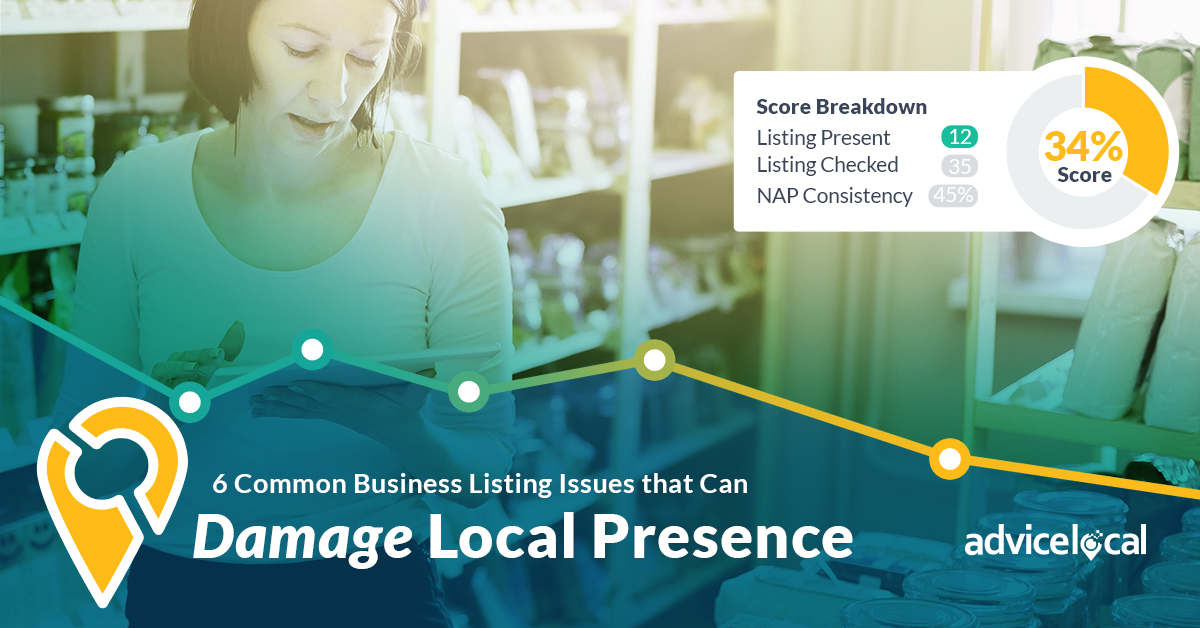For better or worse, there are plenty of factors that can impact a business’ online visibility. How well a business manages its online listings plays a role in determining how often it appears in relevant search results and how many local customers discover the business online.
This means that simply having business listings isn’t enough – businesses must take the initiative to actively resolve listing issues that can damage local presence.
Some of the most common problems for local business listings include:
- Incomplete or missing information
- Outdated, inaccurate or inconsistent NAP data
- Unclaimed or unverified listings
- Low-quality visual content
- Using a single listing for multiple locations
Let’s take a closer look at what causes these issues and how businesses can fix them to protect their local presence.
The Most Common Problems with Local Business Listings
1. Incomplete Listing Information
The more information businesses make available online, the more likely potential customers are to visit the website and store location. So, each business listing should be as detailed as possible. Always include the business name, address, and phone number (also known as NAP data), along with other relevant information.
Some directories allow businesses to include additional information, such as driving directions to the store, photos of the building or products, hours of operation, and other details a customer might want to know before heading to the store or making a purchase.
2. Inaccurate NAP Data
Unfortunately, even if the listing includes NAP data, it’s not always accurate. Whether the business moves, gets a new phone number, or changes its name during a merger or acquisition, there are plenty of ways for NAP data to become outdated.
To keep a business’ NAP data up-to-date across the web and prevent bad data from spreading, business owners should go straight to the source. Data aggregators like Localeze and Infogroup propagate business data to directories and other websites. So, in addition to submitting updated NAP data to relevant directories, it’s critical to make sure the major aggregators always have accurate, relevant information about the business.
3. Duplicate Listings
More data is not always better. In fact, duplicate listings are a huge problem for businesses trying to take control of their local presence management. There should only be one listing per business location in each local business directory.
How do duplicate listings happen in the first place? It might be that the business has changed locations or names and, instead of updating the existing listing, a new listing is erroneously created. Whatever the case, business owners should keep an eye out for duplicates and remove any extra listings they discover.
4. Low-Quality Visual Content
Some directories allow businesses to upload images to help customers visualize where the store is located and what the business offers. However, low-quality images can do more harm than good by giving potential customers an unflattering view of the business or product.
For example, consider how a dark, blurry photo of a restaurant would make you feel about eating there. It doesn’t matter how good the food tastes if a low-quality image online causes potential diners to lose their appetite before they even book a reservation.
Instead, the business should highlight popular merchandise or menu options with flattering photography that offers a realistic perspective. The business should also showcase the storefront so people can easily recognize it when they come to the shop or restaurant.
5. Unclaimed Listings
Another major issue is failing to claim existing listings that are already published and visible online. That’s right, listings can appear without the business owner even realizing! For instance, Google Business Profile (formerly Google My Business) is often auto-generated by information readily available online – which means the business owner might not be aware the listing exists.
This is dangerous for several reasons. One of the main risks is that the listing information will be incorrect. Although Google is pretty good at piecing together information to create a listing, it’s not always the most up-to-date data that gets curated and displayed.
Claiming the listing also allows the business owner to add more detail and optimize the business listing. For example, with a claimed listing, the business can ensure only flattering photos are displayed and make sure the NAP data is 100% accurate.
6. A Single Listing for Multiple Locations
For businesses with more than one location, a single listing per directory is not enough. Whether there are two stores or 2,000, multi-location businesses need to have unique listings for each individual location. After all, each location has its own address and contact information that should be easy to find online. Local customers want details about the most convenient store for them to visit – including NAP, hours, directions and other relevant data.
Many business owners still don’t realize the importance of having a unique listing for each store or location. Individual listings allow multi-location businesses to drive web traffic to their websites and foot traffic to their physical stores. Additionally, each listing should link to a unique landing page specific to the location.
Local Presence Management for Businesses that Want to Get Found
Managing a business’ local presence isn’t easy – especially for someone who is busy trying to run the business, too. If you’d like to hand the local presence reigns over to a team of professionals, get in touch with Advice Local today!





Hi Justin,
Your article is very interesting which is why I shared it. Having your business listed in business listings like Google My business or Bing for Business Places is important because it increases your chances of appearing in both voice and text searches.
I recently wrote an article that was published on the Rocks digital website, where I highlighted the need to get your business on Google My Business.
Infact, 80℅ of all searches are location based, so when marketers fail to implement this strategy, they’re sure missing a lot.
Thanks for sharing.
How “picky” are search engines with NAP info? For instance, in North York was its own municipality until 1998 after which time it and 5 or so other municipalities amalgamated into Toronto.
We have a location in the North York area but on our website we only use Toronto as the City wherever the addess is mentioned. Our “Google My Business” listing was originally entered with Toronto as the City, but it seems Google doesn’t like that and I’ve discovered that our address has been changed to North York.
Technically, using either name is correct, but because the NAP info is inconsistent will that hurt local listing ranks?
Tim, the best rule of thumb is to use whatever address the post office has associated with the location. Inconsistencies definitely impact placement in local search results.